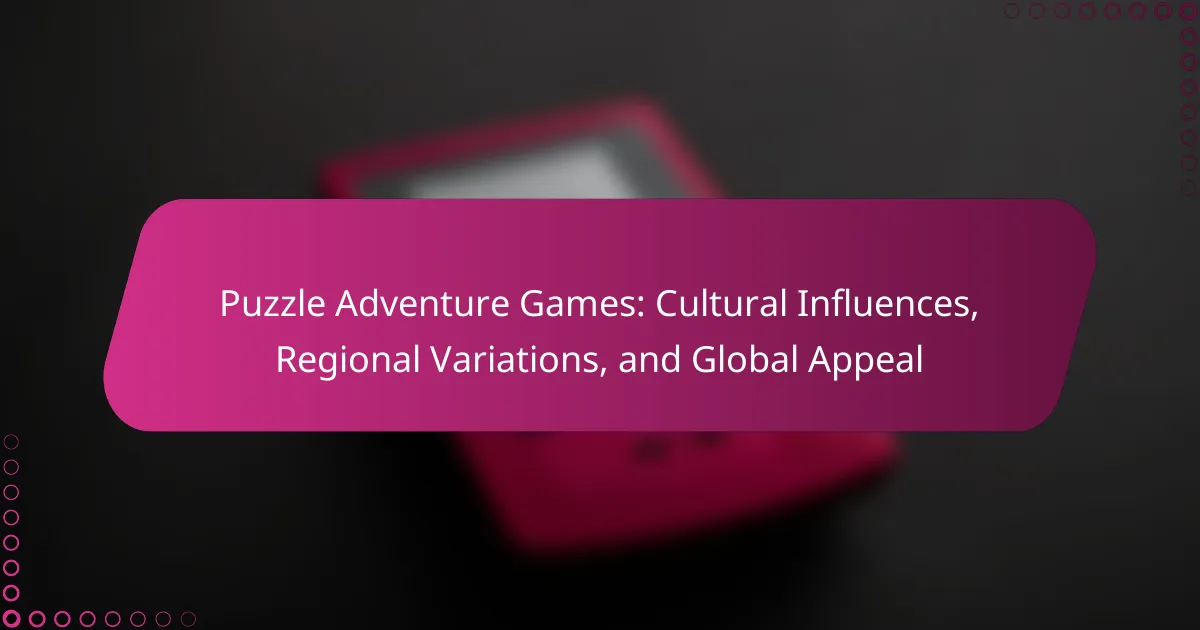Puzzle adventure games offer players immersive experiences through engaging narratives and intricate puzzles. This article explores cultural influences, highlighting regional variations in storytelling and gameplay mechanics. It also examines key platforms for these games, emerging design trends, and the challenges developers face in ensuring cultural sensitivity. Community feedback plays a crucial role in refining these games, enhancing their global appeal while respecting local customs.

How do puzzle adventure games reflect cultural narratives?
Puzzle adventure games reflect cultural narratives by integrating local myths, traditions, and social issues into their gameplay. These games often showcase regional variations that highlight unique storytelling methods, art styles, and problem-solving approaches. For example, games set in Japan might incorporate folklore, while Western titles may focus on historical events. This diversity enhances their global appeal, allowing players to experience different cultures through interactive narratives. As a result, puzzle adventure games serve as a medium for cultural exchange and understanding, bridging gaps between players from various backgrounds.
Which storytelling techniques are most effective in different cultures?
Puzzle adventure games utilize various storytelling techniques influenced by cultural contexts. Effective techniques include narrative structures, character development, and thematic elements that resonate with specific regional values.
Cultural narratives often shape the way stories unfold in these games. For instance, Eastern cultures may emphasize collective experiences and moral lessons, while Western cultures often focus on individual heroism and personal growth. This distinction influences the game’s plot progression and character arcs.
Character development varies across cultures, with some regions prioritizing archetypal figures that embody cultural myths. In contrast, others may favor complex characters with diverse backgrounds and motivations, enhancing player engagement and relatability.
Thematic elements such as conflict resolution, community, and tradition play significant roles. For example, games from cultures with strong communal ties may highlight teamwork and collaboration, while those from more individualistic societies might explore personal quests and self-discovery. These cultural influences contribute to the global appeal and regional variations of puzzle adventure games.
What role do local myths and legends play in game design?
Local myths and legends significantly enhance game design by enriching narratives and creating immersive experiences. They provide cultural depth and regional authenticity, making puzzle adventure games relatable and engaging. Incorporating these elements fosters a unique atmosphere, appealing to players’ curiosity about different cultures. As a result, games often reflect local folklore, which can offer insights into societal values and traditions. This connection not only attracts players but also promotes cultural appreciation and understanding.

What are the defining characteristics of puzzle adventure games?
Puzzle adventure games combine exploration and problem-solving, featuring immersive narratives and engaging gameplay mechanics. Key characteristics include intricate puzzles, rich storytelling, and diverse environments. Cultural influences shape themes and art styles, while regional variations introduce unique gameplay elements. Global appeal stems from their ability to attract players across demographics, offering universal challenges that resonate with a wide audience.
How do gameplay mechanics influence player engagement?
Gameplay mechanics significantly enhance player engagement by providing challenges and rewarding interactions. In puzzle adventure games, mechanics like problem-solving, exploration, and narrative integration create immersive experiences. These elements cater to diverse cultural influences, allowing players from different regions to connect with the game. For example, varying difficulty levels can appeal to both casual and hardcore gamers, fostering a broader global appeal. Engaging mechanics encourage players to invest time, ultimately enhancing their enjoyment and retention.
What are the most common puzzle types found in these games?
Puzzle adventure games feature various common puzzle types that enhance gameplay. These include logic puzzles, pattern recognition challenges, and environmental puzzles. Each type encourages critical thinking and problem-solving skills, appealing to diverse audiences globally.
Logic puzzles often require players to deduce solutions based on given clues. Pattern recognition challenges involve identifying sequences or matching items, while environmental puzzles use the game world to present obstacles that must be navigated creatively. These variations reflect cultural influences and regional preferences, contributing to the genre’s global appeal.

How do regional variations shape puzzle adventure games?
Regional variations significantly shape puzzle adventure games by influencing themes, storytelling, and gameplay mechanics. Cultural elements such as folklore, history, and local customs are often integrated, creating unique experiences. For example, games set in Japan may incorporate traditional motifs and puzzles based on local legends. This cultural depth enriches player engagement and fosters global appeal. Additionally, regional preferences for difficulty levels and puzzle types can lead to diverse gameplay experiences across different markets. By embracing these variations, developers can cater to a wider audience while maintaining the core essence of the genre.
What unique themes are prevalent in North American puzzle adventures?
Unique themes in North American puzzle adventures include diverse storytelling, cultural folklore, and environmental settings. These elements create immersive experiences that resonate with regional identities. For instance, games often incorporate Native American mythology, reflecting local heritage. Additionally, the integration of urban landscapes versus rural backdrops showcases the continent’s geographical diversity. This blend of themes enhances player engagement and fosters a sense of place within the narrative.
Which cultural elements are emphasized in European puzzle games?
European puzzle games emphasize cultural elements such as folklore, art styles, and historical references. These games often incorporate local myths and legends, enhancing immersion. Regional variations manifest in puzzle designs, reflecting cultural practices and languages. Global appeal arises from universal themes and engaging gameplay mechanics.
How do Asian influences manifest in puzzle adventure narratives?
Asian influences in puzzle adventure narratives often manifest through thematic elements, storytelling techniques, and cultural symbolism. These games frequently incorporate folklore, mythology, and traditional art styles, enriching the player experience. For example, titles like “The Legend of Zelda: Breath of the Wild” integrate Eastern aesthetics and philosophies, creating immersive worlds that reflect Asian cultural values. Additionally, gameplay mechanics may draw from Asian traditions, such as puzzle-solving methods rooted in historical practices. These elements foster a unique blend of regional influences and global appeal, making puzzle adventure games diverse and engaging.

What are the key platforms for puzzle adventure games in 2025?
The key platforms for puzzle adventure games in 2025 include PC, consoles, and mobile devices. PC platforms like Steam offer extensive libraries and community features. Consoles such as PlayStation and Xbox provide exclusive titles and optimized gameplay. Mobile platforms, including iOS and Android, attract casual gamers with accessibility and touch controls. Emerging cloud gaming services also present new opportunities for puzzle adventure games, allowing cross-platform play and instant access to a variety of titles.
How does mobile gaming impact the genre’s popularity?
Mobile gaming significantly boosts the popularity of puzzle adventure games by enhancing accessibility and engagement. The genre attracts diverse audiences through its immersive storytelling and challenging gameplay. Regional variations reflect cultural influences, with local themes resonating with players. Global appeal is driven by social connectivity, allowing players to share experiences and strategies. The rise of mobile platforms has democratized access, making these games available to a broader demographic. As a result, puzzle adventure games continue to thrive in the mobile gaming landscape, appealing to casual and dedicated gamers alike.
Which console features enhance puzzle adventure experiences?
Enhanced console features significantly improve puzzle adventure experiences through immersive gameplay and interactive storytelling. Key features include high-resolution graphics, advanced haptic feedback, and innovative control schemes. These attributes create a more engaging environment, allowing players to solve intricate puzzles and explore diverse narratives effectively. Additionally, online multiplayer capabilities foster collaboration, enriching the overall experience by enabling players to share solutions and strategies.

What are the emerging trends in puzzle adventure game design?
Emerging trends in puzzle adventure game design include immersive storytelling, integration of augmented reality, and adaptive difficulty levels. These innovations enhance player engagement and cater to diverse audiences. Cross-cultural themes are increasingly prominent, reflecting global narratives and regional variations. Additionally, community-driven content creation is gaining traction, allowing players to contribute to game worlds.
How is virtual reality changing player interactions with puzzles?
Virtual reality is transforming player interactions with puzzles by creating immersive environments. Players engage more deeply, enhancing problem-solving and collaboration. This technology fosters unique cultural experiences, allowing players to explore regional variations in puzzle design. As a result, puzzle adventure games gain global appeal, bridging gaps between diverse gaming communities.
What innovations are being introduced in narrative structures?
Innovations in narrative structures for puzzle adventure games include nonlinear storytelling, immersive branching narratives, and player-driven plot developments. These approaches enhance engagement and allow for varied cultural influences. For instance, games from Japan often incorporate folklore, while Western titles may focus on character-driven plots. Regional variations lead to unique gameplay experiences, reflecting local storytelling traditions. This global appeal broadens the audience and enriches the genre.

What challenges do developers face in creating culturally sensitive content?
Developers face significant challenges in creating culturally sensitive content for puzzle adventure games. These include understanding diverse cultural narratives, avoiding stereotypes, and ensuring accurate representation.
Cultural nuances can vary widely, leading to potential misinterpretations. Developers must research regional variations to appeal to global audiences while respecting local customs. This requires collaboration with cultural consultants to validate content authenticity.
Balancing global appeal with local relevance is crucial. Developers often struggle to integrate universal themes that resonate across cultures without alienating specific groups. This complexity demands a deep understanding of cultural contexts and player expectations.
Additionally, feedback mechanisms are essential. Developers need to establish channels for cultural feedback from players to refine and adapt content continuously. This iterative process helps mitigate cultural insensitivity and enhances the overall gaming experience.
How can localization improve the gaming experience?
Localization enhances the gaming experience by making puzzle adventure games culturally relevant and engaging for diverse audiences. It allows developers to adapt narratives, visuals, and gameplay mechanics to resonate with regional preferences and cultural nuances.
Localization can incorporate unique attributes such as local myths, languages, and societal norms, enriching the storytelling and immersion. For example, a game set in ancient mythology can include region-specific deities or legends, enhancing relatability.
Additionally, localized content can improve accessibility, ensuring that players understand game mechanics and storylines. This leads to increased player satisfaction and retention, as players feel a deeper connection to the game world.
In summary, effective localization transforms puzzle adventure games into culturally rich experiences, fostering global appeal while honoring local traditions and preferences.
What are the risks of cultural appropriation in game design?
Cultural appropriation in game design risks misrepresentation, reinforces stereotypes, and can lead to community backlash. These consequences affect both creators and players. Developers may unintentionally exploit cultural elements without proper context or respect. This can alienate audiences and diminish the authenticity of the game experience. Additionally, cultural appropriation can overshadow original contributions from marginalized communities, hindering their representation in the industry.

What role does community feedback play in puzzle adventure game development?
Community feedback is crucial in puzzle adventure game development as it shapes gameplay, story, and user experience. Developers use feedback to identify areas for improvement, ensuring the game resonates with players. This iterative process enhances cultural relevance and regional appeal, making games more engaging globally. Incorporating player suggestions can lead to unique features that differentiate a game in a competitive market. Additionally, feedback helps in balancing difficulty levels, promoting satisfaction and retention among players.
How can player input shape future titles?
Player input can significantly shape future puzzle adventure games by fostering creativity and enhancing player engagement. Developers can integrate feedback to refine gameplay mechanics and storytelling elements. This collaboration can result in culturally diverse narratives that resonate with various audiences. Additionally, regional variations in puzzles can cater to local preferences, enriching the overall gaming experience. The global appeal of these games can expand as developers adapt to player insights, ensuring relevance and enjoyment across different cultures.
What are the best practices for engaging with gaming communities?
Engaging with gaming communities effectively requires understanding their culture and preferences. Focus on active participation, respectful communication, and sharing valuable content.
1. Participate regularly in discussions to build rapport.
2. Share insights and tips related to puzzle adventure games to establish expertise.
3. Respect diverse opinions and foster inclusive conversations.
4. Organize or join community events to strengthen connections.
5. Use social media platforms to reach wider audiences and engage in real-time discussions.
What common mistakes should developers avoid when responding to feedback?
Developers should avoid being defensive, ignoring feedback, or failing to follow up. These mistakes can hinder game improvement and player satisfaction. Acknowledging feedback fosters community trust and enhances the game experience. Listening enables developers to adapt to cultural influences and regional variations in puzzle adventure games.




